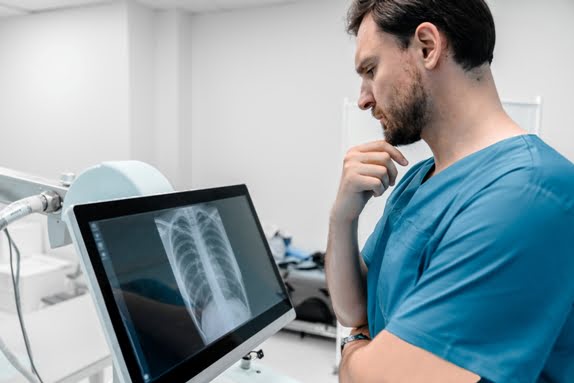Purpose and Indications
The X-ray of the shoulder joint is commonly performed to assess and diagnose conditions that affect the bones and joints of the shoulder. Below are some of the key reasons for conducting a shoulder X-ray:
1] Fractures: Shoulder fractures, including clavicle fractures, humeral fractures, and fractures of the scapula, are among the most common reasons for a shoulder X-ray. The shoulder is highly susceptible to fractures due to falls, accidents, and trauma, and an X-ray is essential to determine the extent and location of the injury.
2] Dislocations: The shoulder joint is prone to dislocations, particularly anterior dislocations, where the ball of the humerus is displaced from the socket of the scapula. An X-ray can confirm the dislocation and help assess any associated fractures or damage to the joint structures.
3] Arthritis: Conditions like osteoarthritis and rheumatoid arthritis can lead to inflammation, degeneration, and joint space narrowing in the shoulder. X-rays are used to identify these changes, such as bone spurs, joint space narrowing, and other signs of wear and tear in the shoulder joint.
4] Rotator Cuff Injuries: Although X-rays cannot directly visualize soft tissues like muscles and tendons, they are often used in conjunction with other imaging methods (such as MRI or ultrasound) to assess the bones for any signs of damage or changes due to rotator cuff injuries. Rotator cuff tears or impingement can lead to changes in bone alignment or the formation of bone spurs.
5] Bone Tumors or Infections: X-rays can help detect bone tumors, cysts, or infections in the shoulder, which may present with abnormal bone growth, changes in bone density, or signs of inflammation. This is particularly important when patients present with unexplained pain, swelling, or other systemic symptoms.
6] Post-surgical Evaluation: After shoulder surgery (such as a shoulder replacement, rotator cuff repair, or fracture fixation), an X-ray is used to monitor the position of the implants, screws, or other hardware and ensure proper healing and alignment of the bones.
For an accurate X-Ray Shoulder Joint in Pune, Diagnopein is your best digital X-ray centre near me. Our advanced digital X-ray technology provides clear, high-quality images of the shoulder joint, helping diagnose conditions like fractures, arthritis, rotator cuff tears, and other shoulder-related issues. The process is quick, non-invasive, and involves minimal radiation. With the expertise of our skilled radiologists, we offer precise reports that assist in guiding your treatment plan. Whether for injury evaluation or routine screening, trust Diagnopein for reliable, fast, and affordable shoulder X-ray services in Pune, ensuring your health is in expert hands.
Procedure and Technique
The X-ray of the shoulder joint is a straightforward, non-invasive procedure that is typically completed in a few minutes. Here's an overview of how the procedure is performed:
1] Preparation: There is typically no special preparation required for a shoulder X-ray. However, you may be asked to remove any clothing, jewelry, or accessories that may interfere with the imaging. In some cases, you may be provided with a gown to wear during the procedure.
2] Positioning: The X-ray technologist will position you in various ways to capture different views of the shoulder. Common views taken during a shoulder X-ray include:
A] Anteroposterior (AP) View: In this standard view, the patient stands or sits with the arm in a neutral position, and the X-ray is taken from front to back.
B] Lateral View: The patient may be asked to turn to the side to provide a side view of the shoulder joint, which helps to better visualize certain structures, such as the glenoid (socket) of the scapula and the head of the humerus.
C] Axillary View: In some cases, an axillary (underarm) view may be taken to assess the shoulder from a different angle, especially when evaluating shoulder dislocations or fractures.
3] Image Capture: Once in position, the technologist will ask you to hold still and may ask you to hold your breath for a brief moment while the X-ray is taken. The process usually only takes a few seconds.
4] Post-Procedure: After the images are captured, the X-ray technologist will review them to ensure they are clear. You can resume normal activities right away, as the procedure is quick and does not require recovery time.









